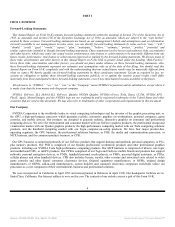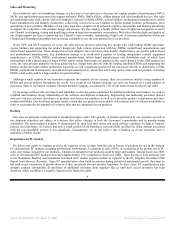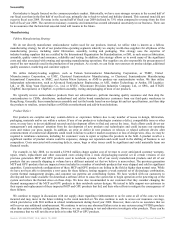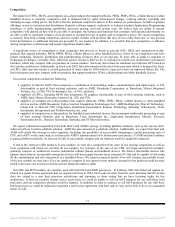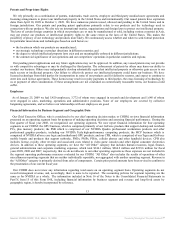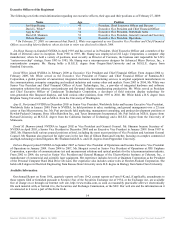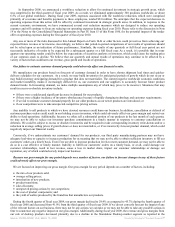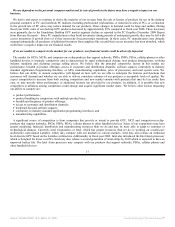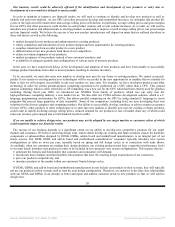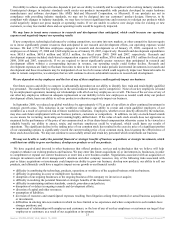NVIDIA 2009 Annual Report Download - page 15
Download and view the complete annual report
Please find page 15 of the 2009 NVIDIA annual report below. You can navigate through the pages in the report by either clicking on the pages listed below, or by using the keyword search tool below to find specific information within the annual report.
Competition
The market for GPUs, MCPs, and computer-on-a-chip products that support netbooks, PNDs, PMPs, PDAs, cellular phones or other
handheld devices is intensely competitive and is characterized by rapid technological change, evolving industry standards and
declining average selling prices. We believe that the principal competitive factors in this market are performance, breadth of product
offerings, access to customers and distribution channels, software support, conformity to industry standard Application Programming
Interfaces, or APIs, manufacturing capabilities, processor pricing, and total system costs. We believe that our ability to remain
competitive will depend on how well we are able to anticipate the features and functions that customers will demand and whether we
are able to deliver consistent volumes of our products at acceptable levels of quality and at competitive prices. We expect competition
to increase from both existing competitors and new market entrants with products that may be less costly than ours, or may provide
better performance or additional features not provided by our products. In addition, it is possible that new competitors or alliances
among competitors could emerge and acquire significant market share.
A significant source of competition is from companies that provide or intend to provide GPU, MCP, and computer-on-a-chip
products that support netbooks, PNDs, PMPs, PDAs, cellular phones or other handheld devices. Some of our competitors may have
greater marketing, financial, distribution and manufacturing resources than we do and may be more able to adapt to customer or
technological changes. Currently, Intel, which has greater resources than we do, is working on a multi-core architecture code-named
Larrabee, which may compete with our products in various markets. Intel may also release an enthusiast level discrete GPU based on
the Larrabee architecture. Additionally, in fiscal year 2009, Intel also introduced the Intel Atom processor which is designed for lower
cost PCs. Intel may also release a second generation of Atom chips by 2010 which is expected to have an improved battery life. The
Intel Atom processor may compete with our products that support netbooks, PDAs, cellular phones and other handheld devices.
Our current competitors include the following:
• suppliers of discrete MCPs that incorporate a combination of networking, audio, communications and input/output, or I/O,
functionality as part of their existing solutions, such as AMD, Broadcom Corporation, or Broadcom, Silicon Integrated
Systems, Inc., or SIS, VIA Technologies, Inc., or VIA, and Intel;
• suppliers of GPUs, including MCPs that incorporate 3D graphics functionality as part of their existing solutions, such as
AMD, Intel, Matrox Electronics Systems Ltd., SIS, and VIA;
• suppliers of computer-on-a-chip products that support netbooks, PNDs, PMPs, PDAs, cellular phones or other handheld
devices such as AMD, Broadcom, Fujitsu Limited, Imagination Technologies Ltd., ARM Holdings plc, Marvell Technology
Group Ltd, or Marvell, NEC Corporation, Qualcomm Incorporated, Renesas Technology, Samsung, Seiko-Epson, Texas
Instruments Incorporated, and Toshiba America, Inc.; and
• suppliers of computer-on-a-chip products for handheld and embedded devices that incorporate multimedia processing as part
of their existing solutions such as Broadcom, Texas Instruments Inc., Qualcomm Incorporated, Marvell, Freescale
Semiconductor Inc., Renesas Technology, Samsung, and ST Microelectronics.
We expect substantial competition from both Intel’s and AMD’s strategy of selling platform solutions, such as the success Intel
achieved with its Centrino platform solution. AMD has also announced a platform solution. Additionally, we expect that Intel and
AMD will extend this strategy to other segments, including the possibility of successfully integrating a central processing unit, or
CPU, and a GPU on the same chip, as evidenced by AMD’s announcement of its Fusion processor project. If AMD and Intel continue
to pursue platform solutions, we may not be able to successfully compete and our business would be negatively impacted.
If and to the extent we offer products in new markets, we may face competition from some of our existing competitors as well as
from companies with which we currently do not compete. For example, in the case of our CPB, our Tegra and GoForce products
primarily compete in architecture used in multimedia cellular phones and handheld devices. We believe that mobile devices like
phones, music players, and portable navigation devices will increasingly become more consumer PC-like and be capable of delivering
all the entertainment and web experiences in a handheld device. We cannot accurately predict if we will compete successfully in any
of the new markets we may enter. If we are unable to compete in our current or new markets, demand for our products could decrease
which could cause our revenue to decline and our financial results to suffer.
Our GPU and MCP products are currently used with both Intel and AMD processors. In February 2009, Intel filed suit against us,
related to a patent license agreement that we signed with Intel in 2004. Intel seeks an order from the court declaring that the license
does not extend to a new Intel processor architecture and enjoining us from stating that we have licensing rights for this
architecture. If Intel successfully obtains such a court order, we could be unable to sell our MCP products for use with these Intel
processors and our competitive position would be harmed. In addition, in order to continue to sell MCP products for use with these
Intel processors we could be required to negotiate a new license agreement with Intel and we may not be able to do so on reasonable
terms, if at all.
12
Source: NVIDIA CORP, 10-K, March 13, 2009 Powered by Morningstar® Document Research℠


